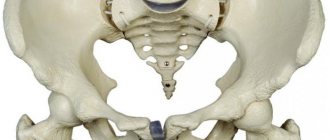The availability of ultrasound diagnostics allows a woman who has just learned about her pregnancy not to speculate about the due date, but to find out exactly how her baby is developing. Naturally, when visiting an ultrasound room, a woman roughly assumes what time the doctor will name, but it happens that her expectations are not met.
How often does this happen, how can we explain the situation when the term according to ultrasound differs from the period according to menstruation, or the size of the fetus differs from the standard at a specific period?
How much can you trust ultrasound?
Ladies who really want to get pregnant want to know about a miracle happening in their lives as early as possible, literally in the first days of the delay. Of course, you can always buy a pregnancy test. But even ultra-sensitive tests can only accurately give a specific answer to the question “has pregnancy occurred?” They are able to answer yes or no, but more precise methods will be needed to set the deadline.
Positive pregnancy test
During a manual examination of a pregnant woman, an obstetrician-gynecologist may notice that the uterus is loose and slightly enlarged. But this phenomenon is also observed before menstruation. To accurately clarify the situation, you will need an ultrasound examination.
Ultrasound can accurately determine pregnancy when the level of hCG (human chorionic gonadotropin) in a woman’s blood exceeds one thousand units. In this case, the doctor is already able to see the fertilized egg in the uterine cavity (in case of multiple pregnancy - two or three fertilized eggs). The longer the period, the more complete the picture the study shows - the doctor will note the presence of not only the fertilized egg, but also the yolk sac in it, or even see the embryo and its heartbeat, and will be able to measure the CTE of the embryo (the distance from the tailbone to the crown).
If your menstrual cycle is more than 30 days, the gestational age according to ultrasound and menstruation may differ significantly.
The following situation often arises: a woman comes for an ultrasound, the doctor asks about the date of her last period, conducts a study, and then announces that the pregnancy most likely turned out to be frozen - the embryo and its heartbeat are not visualized, a fetal egg is visible, the size of which is smaller than it should be be. The doctor may be wrong if a woman had late ovulation. For a significant proportion of women, the menstrual cycle is not the standard 28 days, but 33, or even 35-40. This means that conception did not occur on days 14-16 of the cycle, but a week or two later, and the woman simply came for the ultrasound too early, so the fetus was not seen. Most likely, the pregnancy will not be frozen and the fetus is developing normally, it’s just worth repeating the study in a couple of weeks to make sure there is no mistake. It is also possible to explain the situation when pregnancy is not visible at all on an ultrasound: probably, the level of hCG in the blood is less than that at which pregnancy can be seen.
Signs on ultrasound
Ultrasound diagnostics is the main examination method. In the first case, the death of the child is indicated by the following characteristic signs:
- the growth of the fertilized egg is slow, and its diameter does not exceed 24 mm;
- there are no signs of an embryo;
- there are no symptoms of pregnancy progression.
There is a second type of frozen pregnancy. This type is more difficult to diagnose. The fertilized egg grows normally, but there is no embryo in it or there are only its remains. The villous chorion is not visualized.
When the embryo remains in the uterus for a long time, the main symptoms are not enough. You need to pay attention to accompanying signs, which include:
- severe deficiency of amniotic fluid;
- deformations of the fetal egg - constrictions and unclear contours;
- discrepancy between the size of the fertilized egg and the required standards.
One of the main signs is the absence of a heartbeat on ultrasound.
All of these symptoms indicate a frozen process of bearing a child. Doctors have also developed a set of signs by which you can independently understand that the pregnancy has stopped. These include:
- absence of an embryo with a heartbeat 12 days after ultrasound diagnostics showed a fertilized egg with a yolk sac;
- absence of embryo with a diameter of 25 mm;
- absence of heartbeat with a CTE of 7 mm.
However, a qualified doctor should interpret the results.
Differences in pregnancy terms according to menstruation and ultrasound
Obstetric gestational age is calculated by week
All obstetricians and gynecologists use the term “obstetric period” when determining the duration of pregnancy. This allows all gynecologists in the world to speak the same language. It is carried out in weeks, counting from the first day of the last menstruation. The first and second obstetric weeks are those weeks during which the egg is still maturing in the body, which will subsequently be released from the ovary during ovulation and meet with the sperm.
Thus, a woman who has a standard menstrual cycle of 28 days and comes to the doctor with a delay of one week will be diagnosed with pregnancy at exactly five obstetric weeks. At the same time, an ultrasound examination can set a slightly shorter period - three or four weeks. How justified is this and why does the deadline not match? This situation is normal, since ultrasound does not aim to determine the exact period in weeks, but to determine how many weeks from conception the fetus is developed according to its parameters (its gestational age). Understanding the difference between these two concepts is important. Therefore, a discrepancy of 1-2 weeks between the period according to menstruation and according to ultrasound in favor of menstruation (i.e., the period according to menstruation is longer, but according to ultrasound is less) is a common occurrence, there is nothing terrible about it.
Baby's gender
Ultrasound examination also makes mistakes when determining the sex of the unborn child. Let's look at the common reasons for this error:
- Short term. The initial diagnosis of the fetus is scheduled from the 11th to the 13th week. During this period, the specialist often incorrectly determines the gender. The purpose of the study in the first trimester is to assess the state of formation of the child’s organs and exclude possible pathologies.
- Twins, triplets. Under such circumstances, it is difficult to determine the sex of babies.
- Features of development. In some cases, determining the gender of the fetus is complicated by swelling of the labia in girls. Therefore, the doctor makes a mistake and puts male gender in the diagnostic results.
- Outdated ultrasound machine. When performing an ultrasound, the device incorrectly displays contours and lines due to outdated software and technical specifications. Therefore, the doctor is mistaken.
- Late deadline. At 32-34 weeks, the baby often closes and does not allow the genitals to be seen.
Additionally, read the article: How does an ultrasound differ between a boy and a girl? Find out at what time the differences are visible.
Ultrasound can only be wrong in certain circumstances. To prevent misdiagnosis, a person undergoes repeated examination.
Have you encountered ultrasound inaccuracies? Tell your story. Share the article with your friends on social networks. Be healthy.
How to determine the gestational age with an irregular cycle?
Some women suffer from hormonal imbalances and, as a result, irregular cycles. With pathologies such as polycystic disease, multifollicular ovaries, and excessive amounts of male sex hormones, menstruation may not occur for several months. However, ovulation with such disorders still occurs from time to time, which means that such women have almost the same chance of getting pregnant as others.
The girl remembers the date of her last menstruation
If pregnancy is not desirable for you, the use of contraception is mandatory, even if you suffer from irregular cycles and have not had a period for several months.
Often, women with irregular cycles do not consider it necessary to use protection, believing that they will definitely not be able to get pregnant. In this case, you can detect pregnancy in the third or even fourth month, because the absence of menstruation for several months becomes a kind of norm. Correct calculation of the obstetric term in such a situation is practically impossible, therefore, when determining the term, the doctor can rely solely on ultrasound data. If the fetus is not too large or too small, ultrasound can determine the gestational age of the fetus to within 2-3 weeks. The date of birth will also be determined using an unconventional method - by counting 40 weeks from the first day of the last menstruation, and relying on ultrasound data.
Gallery of pictures
Pictures in order:
Female genital organs on ultrasound in 3D mode in the third trimester
Male genital organs of the fetus at 21 weeks of gestation
Male genital organs of the fetus in 3D mode in late pregnancy
Ultrasound at 12 weeks. The angle of the genital tubercle with the back of the girl is less than 30 degrees.
Ultrasound at 12 weeks. The angle of the genital tubercle with the back in a boy is 30 degrees.
Ultrasound errors in determining gender: human factor or machine inaccuracies? — subtleties of diagnostics on ForeverHealth.ru
Source
Share the link and your friends will know that you care about health. Thank youツ
In what cases is the term according to ultrasound ahead of the obstetric one?
Currently in Russia, all pregnant women are given the right to undergo free ultrasound examinations three times. They are usually prescribed between 11 and 14 weeks, between 18 and 22, and between 32 and 34. Each of these ultrasounds has its own goals (the first is to determine whether gross malformations of the fetus and genetic abnormalities have been detected, the second is to monitor the development of internal organs, the third is determining the condition of the placenta, the position of the fetus and its approximate weight). However, with each examination, the doctor determines how many weeks the fetus is developed. And often this period is ahead of the obstetric period. For example, a woman knows for sure that her pregnancy is 20 weeks, and the doctor indicated in the conclusion that the size of the fetus corresponds to 22 weeks. Why is this situation happening? There is no error in it. This can be explained as follows:
- The fruit is large. The large size of the fetus, which is ahead of its gestational age, is not a pathology. Just like all people, the fetus already in the womb has its own individual characteristics.
- The size of the fruit is slightly smaller than it should be. This may well be a variant of the norm; perhaps the baby is just small, especially if his parents are not tall and impressive in weight.
- Obstetric weeks are incorrectly defined. There are cases when bleeding, which a woman mistakes for her next period, is actually a threat of miscarriage during a pregnancy that has already occurred in the previous cycle. This phenomenon is popularly called “washing the fetus.” It turns out that the woman tells the doctor one date of her last menstruation, believing that conception occurred in this cycle, whereas in fact it happened in the previous one, and accordingly, the obstetric period will be longer.
Ultrasound error in determining the sex of the child
Modern technologies make our lives easier and more comfortable.
Now it’s hard to imagine not being able to determine the sex of the child during pregnancy. Ultrasound examination is a standard procedure that any pregnant woman can undergo. Does ultrasound make mistakes when determining the sex of a child?
Currently, there are several types of ultrasound: ultrasound fetometry, Doppler ultrasound, screening ultrasound, 3 D and 4 D ultrasound. But are there any mistakes when determining the sex of a child in this way? Undoubtedly, there are errors, their causes may lie both in the hardware and in the specialist.
How often is ultrasound wrong?
There is always a possibility of error, both up and down, when determining the due date using ultrasound. Why does this happen and how many factors are to blame for this? There are several of them: outdated equipment, insufficient qualifications of a functional diagnostics doctor, confusion with the date of the last menstruation, the fetus was not immediately seen, the individual characteristics of the fetus (too large or too small). You can minimize the risk of an error occurring. It is enough to visit trusted medical centers where the level of qualifications of doctors and the quality of equipment is beyond doubt, and also to carefully monitor your cycle and know exactly the date of your last menstruation.
How does the procedure work?
During this examination, the woman lies on her back and bends her knees slightly. The examination begins with a transvaginal examination; then transabdominal is done. At the second and third ultrasound, only a transabdominal examination is performed.
The examination does not cause any inconvenience to the woman and does not harm the child. A pregnant woman can ask the doctor all the questions that interest her. After completion of the procedure, a protocol is issued.
Thus, despite the high accuracy of ultrasound examinations, there is still some risk of medical errors. There are many reasons for this phenomenon. However, if a woman follows all the recommendations for preparing for an ultrasound and uses modern equipment, it is possible to obtain the most accurate result.
Was there a boy?
The most intimate question entrusted to ultrasound can have a sad result. An ultrasound examination may simply not “see” the onset of conception. This means that the woman continues to lead her usual life, without denying herself anything. And after a couple of months she realizes that she is pregnant. But how much could happen during this time!
Obstetric ultrasound can be considered reliable starting from the seventh week of pregnancy. Before this period, it is better to play it safe by donating blood for hCG (human chorionic gonadotropin).
Why does the fetus stop developing?
Fading pregnancy is provoked by a number of reasons, which are important to know about even before conception. These include:
- fetal pathologies incompatible with life;
- Rhesus conflict;
- numerous abortions in history (antibodies produced by the body interfere with the development of the fetus);
- diseases of individual organs;
- injuries during pregnancy;
- excessive physical activity;
- medications contraindicated for pregnant women;
- chemical intoxication.
One of the most common causes of frozen pregnancy in the early stages, diagnosed by ultrasound, is a bacterial infection acquired through sexual contact. Typically the problem is developmental:
- chlamydia;
- ureaplasma;
- gardnerella.
The causative agents of ureaplasma, gardnerella, chlamydia.
Bacteria block the child’s development processes, the body devotes all its strength to fighting them and is not able to defeat infections. All this leads to the death of the embryo.
Women who abuse alcohol are at risk. Alcohol negatively affects the development of the baby and inhibits the natural processes of formation of his brain and nervous system. It is noteworthy that even a seemingly insignificant portion of an alcoholic drink can affect the progress of bearing a child.
Every expectant mother can reduce the likelihood of developing a frozen pregnancy if she wants. You need to start with a full diagnostic examination during the period of planning a child, followed by treatment of detected problems. In addition, when planning to become a mother, a woman should give up bad habits and reconsider her training schedule if sport occupies a special place in her life.
It is extremely necessary that in anticipation of pregnancy and with its onset, a woman makes new useful changes to her lifestyle, establishes a diet, walking and rest schedule, and registers with a doctor to monitor her condition.
Probability of ultrasound error when determining the sex of a child 2020
Progress does not stand still and two-dimensional ultrasound machines are being replaced by three- and four-dimensional ones. Outwardly they look exactly the same. But image quality, special modules and sensors make it possible to expand diagnostics when using 3D and 4D ultrasound. And besides qualitative research, “volumetric” ultrasound brings great joy and aesthetic pleasure to future parents. Because on the screen of the device, the child looks as he really is, and not just an incomprehensible blot and diagram. And yet, even here, there are some nuances when determining gender.











